Participants
Click on name to see their abstract and elevator pitch video.

Muscle development involves a number of finely tuned processes. In recent years, long non-coding RNAs (lncRNAs) have been discovered to be involved with differentiation and cell proliferation. A specific lncRNA, Meg3, is known to be involved in several cellular processes in mammalian cells. We hypothesize that the Meg3 lncRNA is involved in these same processes in the context of skeletal muscle cell differentiation. To examine this, we have begun cloning the Meg3 lncRNA into a tetracycline-inducible expression system, Tet-pLKO. Using C2C12 skeletal muscle myoblasts as our model of skeletal muscle differentiation, we will overexpress the Meg3 lncRNA in C2C12 cells to characterize its role in the muscle differentiation process. Additionally, we have generated C2C12 cells with the Tet-pLKO empty vector integrated into the cells’ genome as a negative control. Characterizing the role of Meg3 in differentiating C2C12 myoblasts will allow us to better understand the role of lncRNAs in skeletal muscle differentiation.
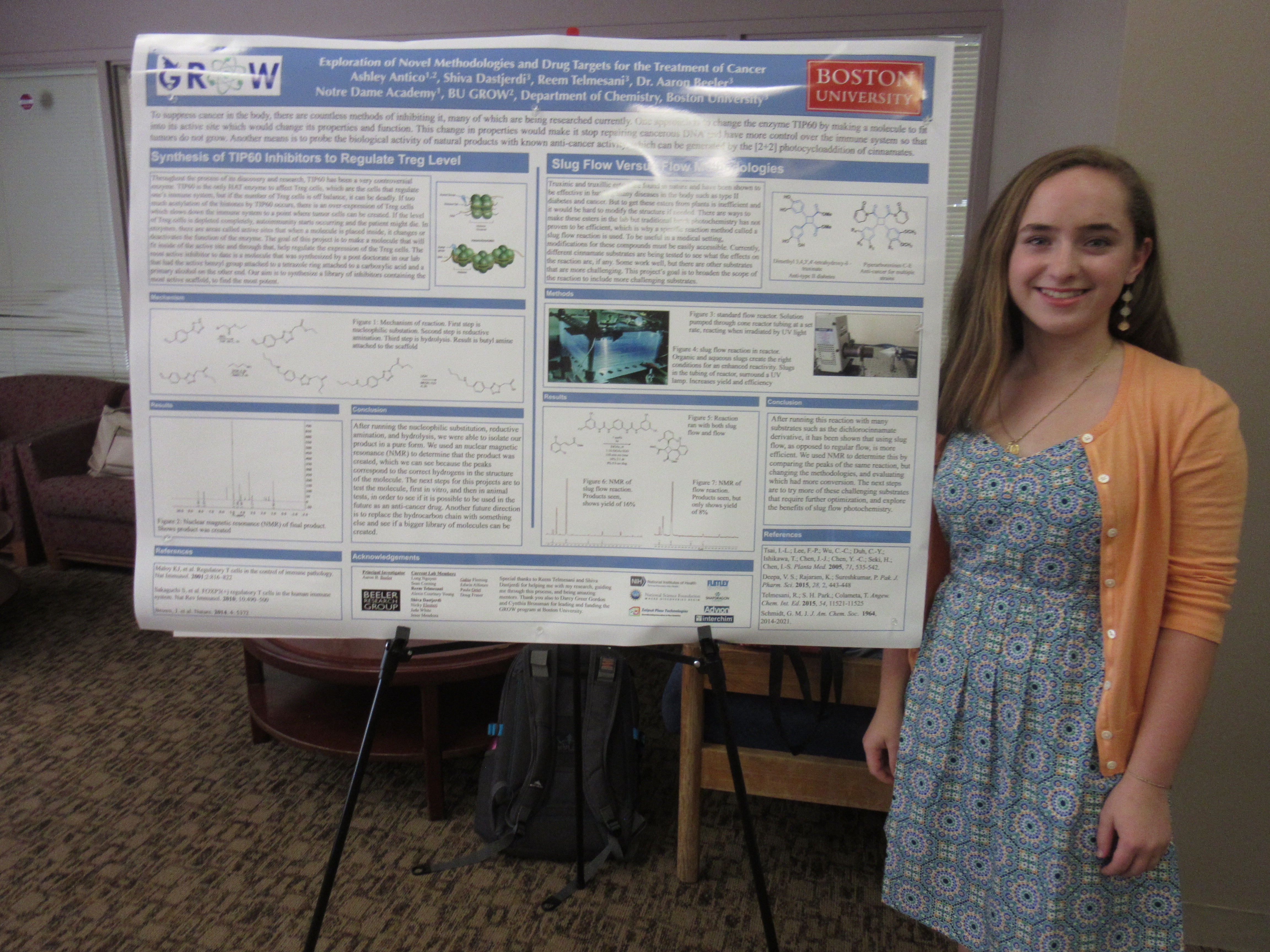
Cancer is a serious disease that impacts many lives throughout the world. New methodologies in photochemistry, like slug flow, are being researched as ways to make and improve the efficiency of making molecules, such a piperarborenines C-E, which are found in natural products that are affective in battling this disease. Another strategy being explored is synthesizing a molecule to fit in the active site of the protein TIP60 which will then help regulate Treg cell levels in order to avoid the creation of tumors. Both of these approaches are being examined as ways to stop cancer from taking and changing so many lives.
The molecules piperarborenines C-E are found in natural products and have anti-cancer properties, but extraction from plants is inefficient and produces only a small amount of product. The base scaffold of these molecules can be synthesized but again, the efficiency is low, so we are testing different cinnamate substrates to see if the amount of product can be increased in a smaller amount of time. Standard batch photochemistry has been shown to be inefficient, so we are exploring and comparing slug flow and flow photochemistry to see which provides better results. Our preliminary reactions have showed that the slug flow method is better than the regular flow, due to the coating of organic material that is on the tubing as a result of biphasic interactions with water, which increases reactivity. The goal is to continue increasing the yield of the desired product in order for the molecules to be explored further.
The HAT protein TIP60 acetylates Foxp3 in Treg cells which regulates Treg expression levels. If too much acetylation occurs, an over expression of Treg cells occurs and the immune system slows down to a point where tumor cells can be created. Conversely, if the level of Treg cells is depleted completely, autoimmunity starts inducing and the patient might die. A scaffold that regulates the TIP60 levels has already been created, but requires modifications. Our aim is to synthesize a library of inhibitors that contain the most active scaffold, 2-(5- phenyl-2H-tetrazol- 2- yl)acetic acid to find the most potent inhibitor. In order to synthesize the inhibitor, we started with nucleophilic substitution on the tetrazole ring, followed by reductive amination of the aldehyde, and finished with hydrolysis of the ester to get the final product. We are aiming to test this molecule in vitro on a HAT inhibition assay and later, in vivo.

The Toll-Like Receptor (TLR)-to-N F-kB signaling pathway is a well characterized innate immune pathway that is highly conserved from humans to flies. Due to increased genomic and transcriptomic sequencing, it has recently been discovered in basal organisms such as the phylum Cnidaria, which contains jellyfish, hydra, sea anemone, and the endangered coral, Orbicella faveolata. An identified TLR from Orbicella faveolata (Of) has domain homology suggesting it could act in a manner similar to human TLR4, but it is currently unknown whether these basal organisms possess a functioning TLR. Therefore, we wish to design and synthesize an Of-TLR capable of stable transfection and pull-down assays. Humans possess adaptor proteins to TLR4, MyD88 and Mal, which interact with TLR4 and are needed to transmit the signal from extracellular ligands to NF-kB to initiate transcription. However, we do not know if Of-TLR is also able to interact with these proteins. In order to test our hypothesis, we must use methods and techniques such as: polymerase chain reaction (PCR), cloning by restriction enzymes, protein and nucleic acid purification, western blots, pull- downs and gel electrophoresis. There are mostly two reasons why there is research of the transcription factor known as NF-kB. The first reason is that the research is being conducted for the sake of science. There is so much to learn about our immune system, and in order to do so, it is crucial to learn about the evolution of the immune system. Secondly, the TLR-to-NF-kB signaling pathway is able to provide insight since it is conserved in basal organisms such as Orbicella faveolata, which leads us to our second reason. Because ocean temperatures are on the rise due to the effects of anthropogenically-caused climate change, understanding the immune response of these organisms will better our knowledge of how stress affects these organisms, and provide possible solutions to aiding these organisms as they undergo stress.

Conventional methods of treating burns, such as sutures and dressings, can oftentimes prolong pain and trauma for both the patient, and the wounded skin. An alternative method of treating burns is through the usage of hydrogels, which are three-dimensional networks of polymer chains that form due to the cross linkages that occur between two molecules with multiple functions. We worked to create hydrogels that consisted of a crosslinker, either NH2 or maleimide, and a dendrimer, either NHS or thiol. The hydrogel consisting of NH2 and NHS formed nicely in ice. However, with the thiol dendrimer, we noticed that when mixed with a basic borate buffer, deprotonation would occur and the solution would turn pink as a result of the disulfide bonds that formed between the thiol molecules. The formation of such bonds weakens the networks within the hydrogel, thus resulting in the creation of a gel that is unable to maintain a solid form. To evaluate this concern, we ran experiments by adding different amounts of a reducing agent, TCEP, to the borate buffer. Testing the absorption spectroscopy of each experiment allowed us to compare the solutions with 20 mM and 40 mM TCEP with the control group without TCEP. Our results suggest that the control and experimental solutions yield similar results. Therefore, the amounts of TCEP that we added were not sufficient in breaking the disulfide bonds.
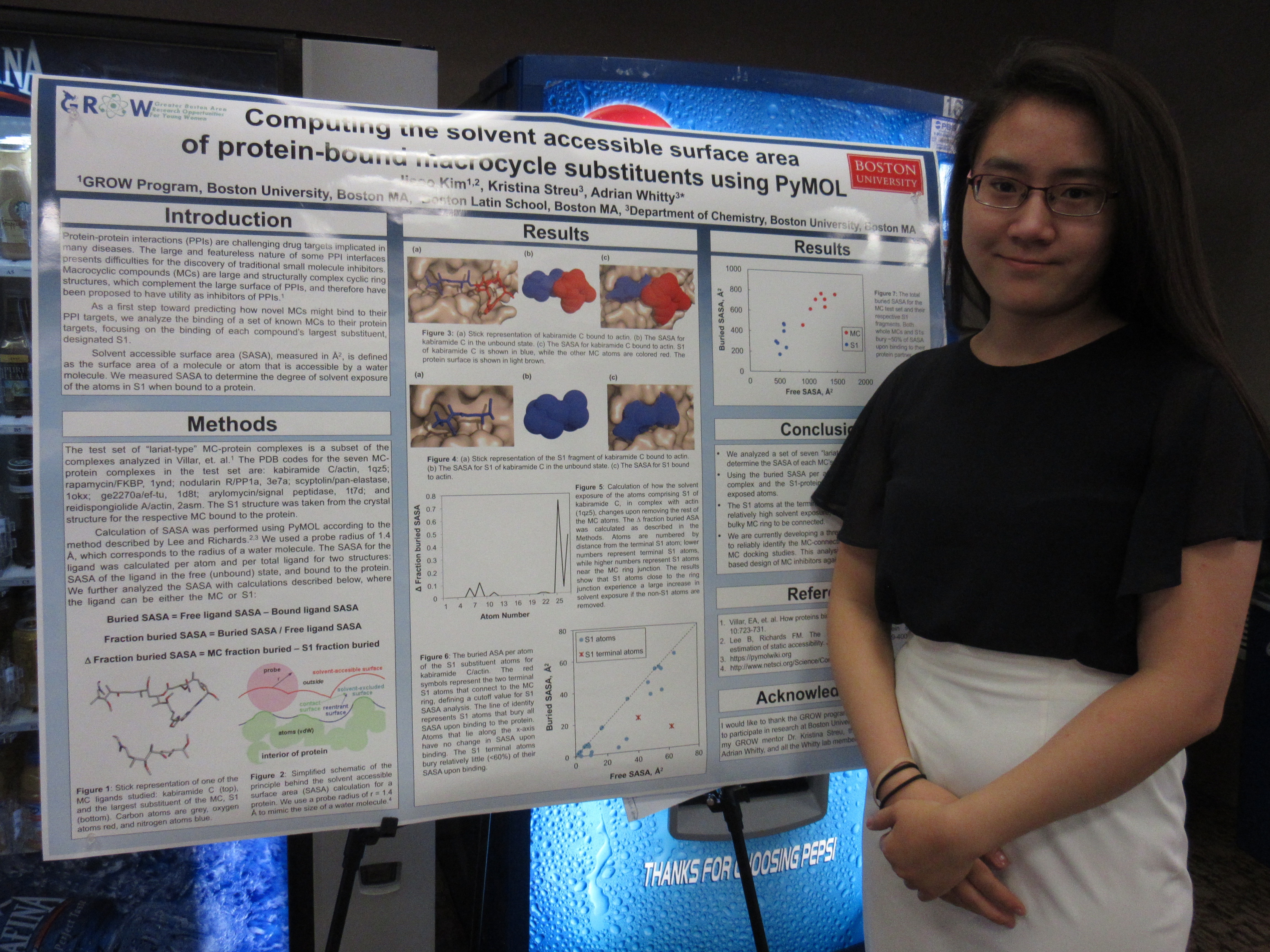
Macrocyclic compounds (MCs) are proposed to be useful as inhibitors of protein-protein interactions (PPIs), which are challenging drug targets implicated in many diseases. However, computational approaches toward predicting MC-protein binding interactions, for example by computationally “docking” large and structurally complex MCs to protein targets, have not yet been successful, presenting an obstacle to structure-based drug design using MCs. We are testing whether computational prediction of MC binding geometries can be facilitated by first docking just the compound’s largest substituent, designated S1. For “lariat-type” MC structures, where S1 contains more than fifteen heavy atoms, this substituent likely contributes substantially to the binding interaction, and reliable methods exist for docking molecular fragments of this size. A problem with this approach is how to tell whether S1 has docked in a pose with sufficient space around the appropriate end to allow a bulky MC ring to be connected to S1 at that position. We used PyMOL, a python-enhanced 3D molecular graphics and computational tool, to calculate the solvent accessible surface area (SASA) of S1 fragments, for a test set of known MC-protein complexes for which crystal structures are available. The results show that the atoms at the end of S1 that connects to the MC ring can be distinguished by their higher degree of solvent exposure. We are currently developing an SASA threshold that can be used to reliably identify the exposed S1 terminus, for use in future docking studies. This analysis, combined with subsequent docking of the full MC structure based on the best S1 binding poses, will help guide the structure-based design of MC inhibitors against specific PPI targets.
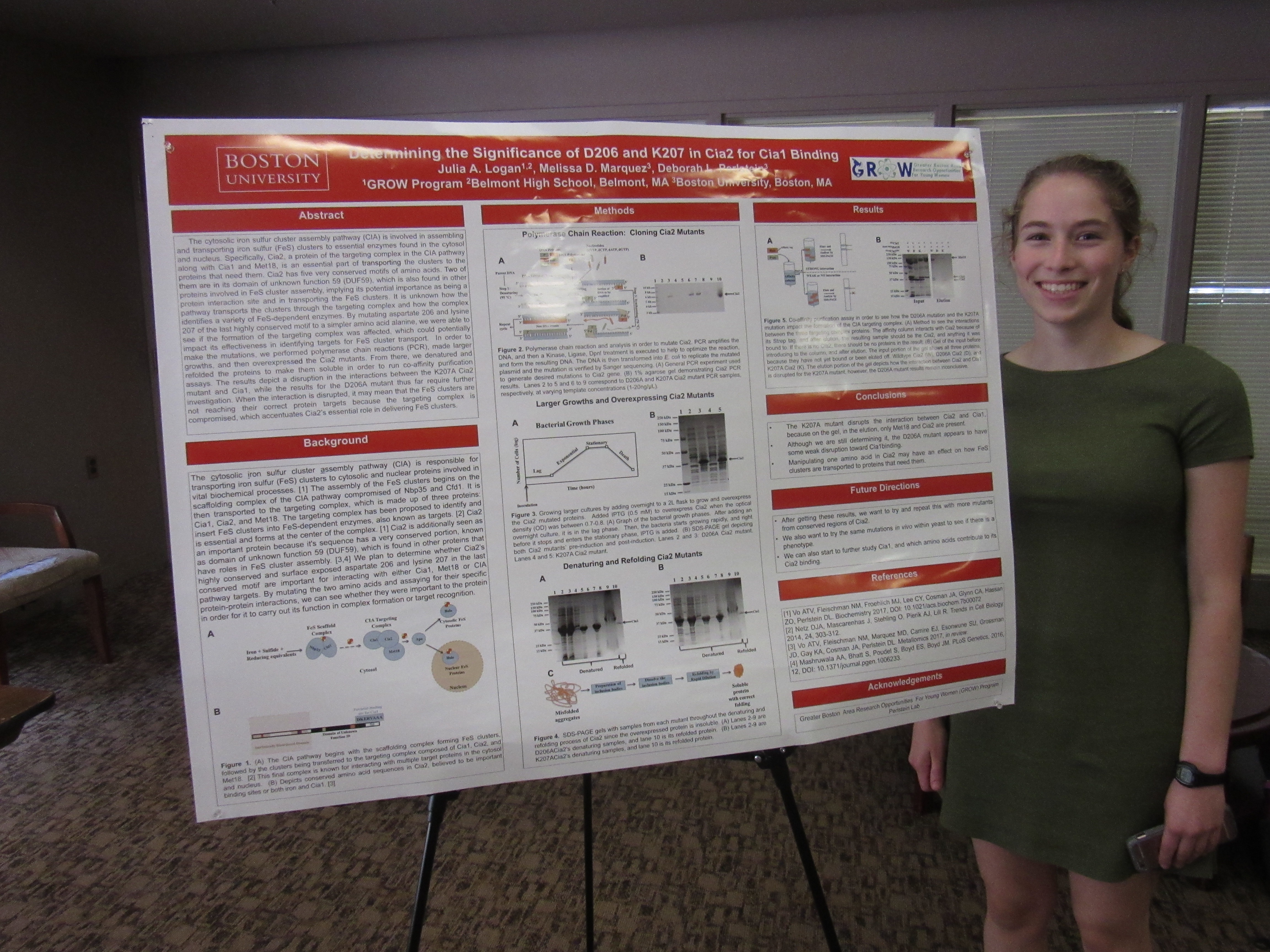
The cytosolic iron sulfur cluster assembly pathway (CIA) is involved in assembling and transporting iron sulfur (FeS) clusters to essential enzymes found in the cytosol and nucleus. Specifically, Cia2, a protein of the targeting complex in the CIA pathway along with Cia1 and Met18, is an essential part of transporting the clusters to the proteins that need them. Cia2 has five very conserved motifs of amino acids. Two of them are in its domain of unknown function 59 (DUF59), which is also found in other proteins involved in FeS cluster assembly, implying its potential importance as being a protein interaction site and in transporting the FeS clusters. It is unknown how the pathway transports the clusters through the targeting complex and how the complex identifies a variety of FeS-dependent enzymes. By mutating aspartate 206 and lysine 207 of the last highly conserved motif to a simpler amino acid alanine, we were able to see if the formation of the targeting complex was affected, which could potentially impact its effectiveness in identifying targets for FeS cluster transport. In order to make the mutations, we performed polymerase chain reactions (PCR), made larger growths, and then overexpressed the Cia2 mutants. From there, we denatured and refolded the proteins to make them soluble in order to run co-affinity purification assays. The results depict a disruption in the interactions between the K207A Cia2 mutant and Cia1, while the results for the D206A mutant thus far require further investigation. When the interaction is disrupted, it may mean that the FeS clusters are not reaching their correct protein targets because the targeting complex is compromised, which accentuates Cia2’s essential role in delivering FeS clusters.
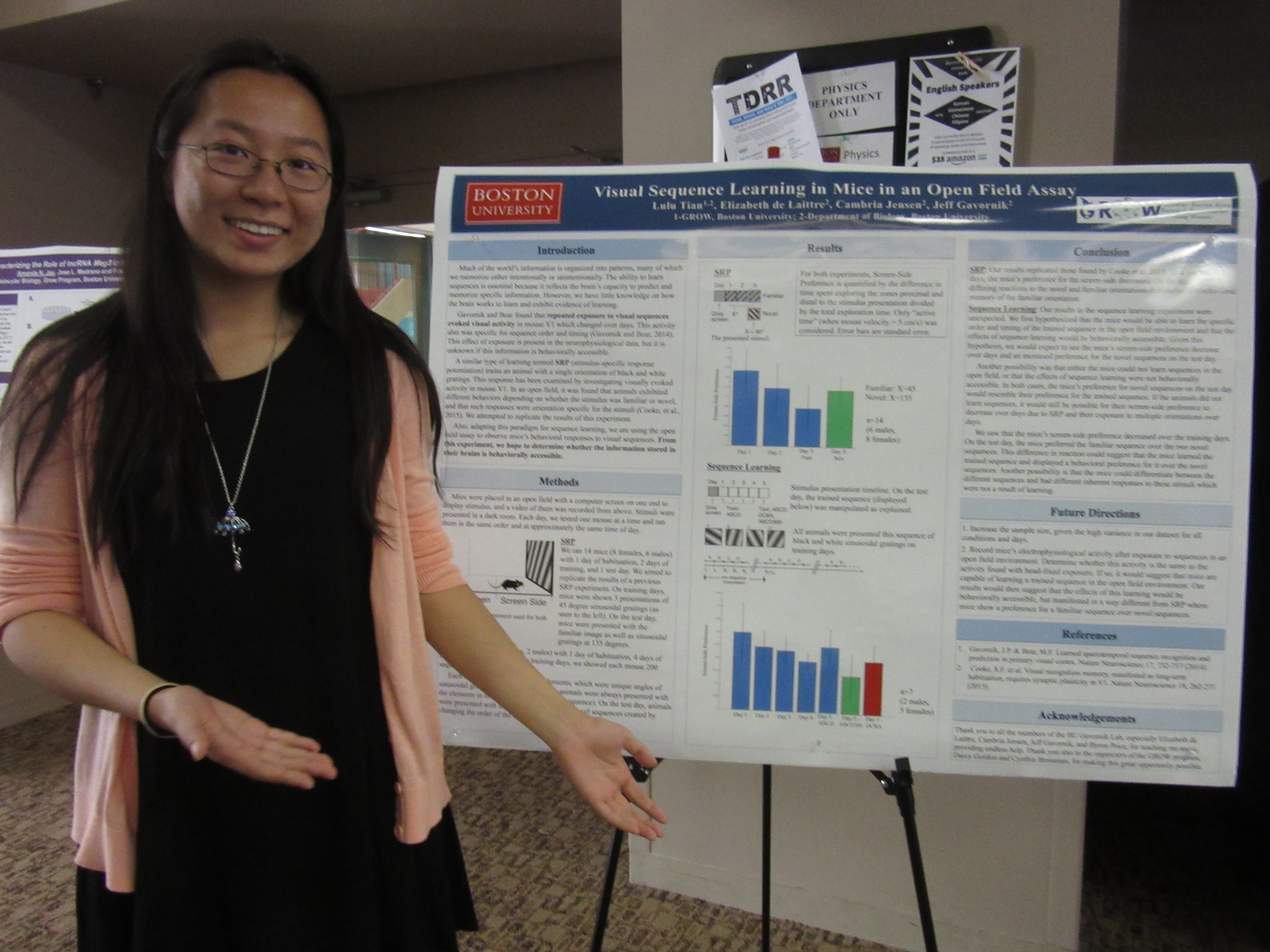
Examining the process of sequence learning provides information about the unknown mechanisms of memory and prediction in the brain. It has been shown in previous experiments that exposure to visual sequences evokes time and orientation specific activity in mouse V1. The open field assay has been used to test mice’s behavioral responses to other stimuli, but has not ever been run with sequence learning. So, it is yet to be determined whether or not the information reflected by activity in the V1 is behaviorally accessible to the mice. We ran an open field assay where mice were trained with a specific sequence for four days, and were tested on the fifth day with novel sequences. We saw that the mice’s screen-side preference decreased over the training days, while on the test day, the mice preferred the familiar sequence over the two novel sequences. This result was unexpected because it has been shown that mice have a behavioral preference for novel images after being habituated to a single image. More research is needed to further explore the relationship between this behavior and the corresponding neurophysiology.

Larval sea urchin skeletal development is a tractable model for pattern formation and molecular signaling in more complex organisms. Larval skeletons are formed by a migratory population of cells called primary mesenchyme cells (PMCs), whose behavior in skeletal development is a useful model for other migratory cells, including metastatic cancers. The cytoskeleton within the PMCs in part causes their migratory behavior, and contributes to cell adhesion and intercellular signaling. Here, we research the specific effect of the cytoskeleton on PMC migration and skeletal patterning. Developing embryos were treated with the drugs Nocodazole, Paclitaxel, and Cytochalasin D to inhibit the microtubules and actin filaments that compose the cytoskeleton. Resulting phenotypes of dosed embryos were recorded by polarized light microscopy and immunostaining for PMC positioning. Paclitaxel does not produce abnormal phenotypes in the larval skeleton, even at high doses. Cytochalasin D-treated embryos exhibit rod stunting and rod duplication. Nocodazole-treated embryos exhibit severe rod loss, especially affecting the secondary skeleton.
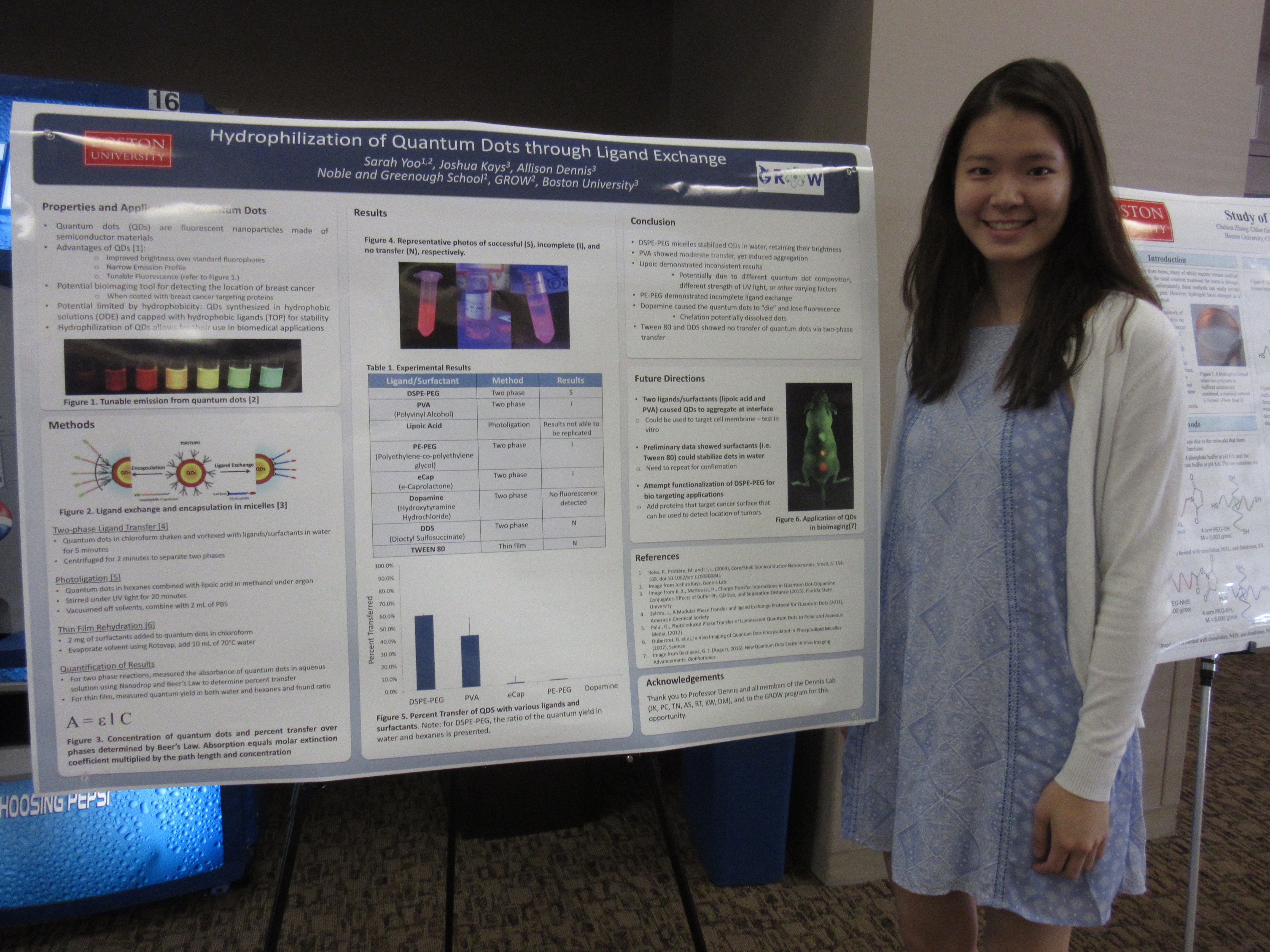
Quantum dots (QDs) are nanocrystal semiconductors that have tunable fluorescence, a narrow emission profile, and are extremely bright in a stable environment. However, quantum dots are typically synthesized in hydrophobic solvents and coated with hydrophobic ligands, preventing their use in biomedical applications. Ligand exchange techniques change the surface coating of ODs, allowing the transfer of QDs to water. Thus, we used three techniques (two-phase ligand transfer, photo ligation, and thin film rehydration) to test over six common ligands and surfactants. We found that DSPE-PEG, lipoic acid, and polyvinyl alcohol have all facilitated the transfer of quantum dots across water, to different degrees.
For billions of years, nature has perfected processes within organisms for the synthesis and utilization of necessary compounds in an energy-efficient way. Human attempts at replication of such processes have resulted in labor and energy intensive operations, achieving the same result with much more work. One of the most important chemical processes is that of oxidation, which utilizes oxygen to transform molecules; however, human efforts to date have relied upon high-energy processes with harmful byproducts. Enzymes of mononuclear non-heme iron oxygenases (MNOs), or iron metalloproteins, contain an iron center facially coordinated to two amines and a carboxylate ligand. One open face allows for three binding sites for cofactors, substrates, or dioxygen. In the Caradonna laboratory, a catalyst has been developed that mimics this behavior. This complex is currently being studied to elucidate its mechanism and, potentially, to infer how the enzyme carries out its oxidation reactions. The addition of different ligands – with variable electronic or steric properties – are studied to improve complex solubility, stability, and/or reactivity. This work looks at expanding the modifications of the basic N2O1 ligand structure to include ketone-derived alkyl substituents for improved ligand solubility and complex stability. A reductive amination with acetone was successfully completed, allowing synthetic conditions for further elaboration of the basic N2O1 ligand. In addition, an N-adamantyl N2O1 ligand was prepared to ultimately improve ligand solubility. Finally, the feasibility of selective reductive amination of the primary amine over the secondary amine in N-methylethylenediamine was demonstrated by the synthesis of a mono-methylated N2O1 ligand. Together, these synthetic developments provide routes towards further elaboration and modification of the core N2O1 ligand structure.

Cell death and corpse clearance are two important processes that allow for homeostasis in organisms. There are several forms of cell death including the well-characterized forms of apoptosis and necrosis, and the newly identified phagoptosis. After death occurs cell corpses are cleared by phagocytes. The McCall lab studies specific proteins responsible for cell death and corpse clearance. In this investigation, we studied the effects of kinases on follicle cell engulfment in the Drosophila ovary. Follicle cells act as phagocytes that clear away nurse cell bodies that have dumped their nutrients into the growing oocyte. To identify the role of kinases in cell corpse clearance, the GAL4UAS system was used to create an RNAi knockdown of specific kinases in the follicle cells of the Drosophila ovary. Knocking down crucial kinases led to defects in the clearance of nurse cells by the follicle cells. Kinases that presented a phenotype of clearance defects included AMPK?, Monopolar spindle 1, center divider, and three heretofore uncharacterized genes – CG8298, CG11486, and CG7766. These findings will allow researchers to gain a broader understanding of cell death and corpse clearance which play roles in diseases such as cancer and neurodegeneration.
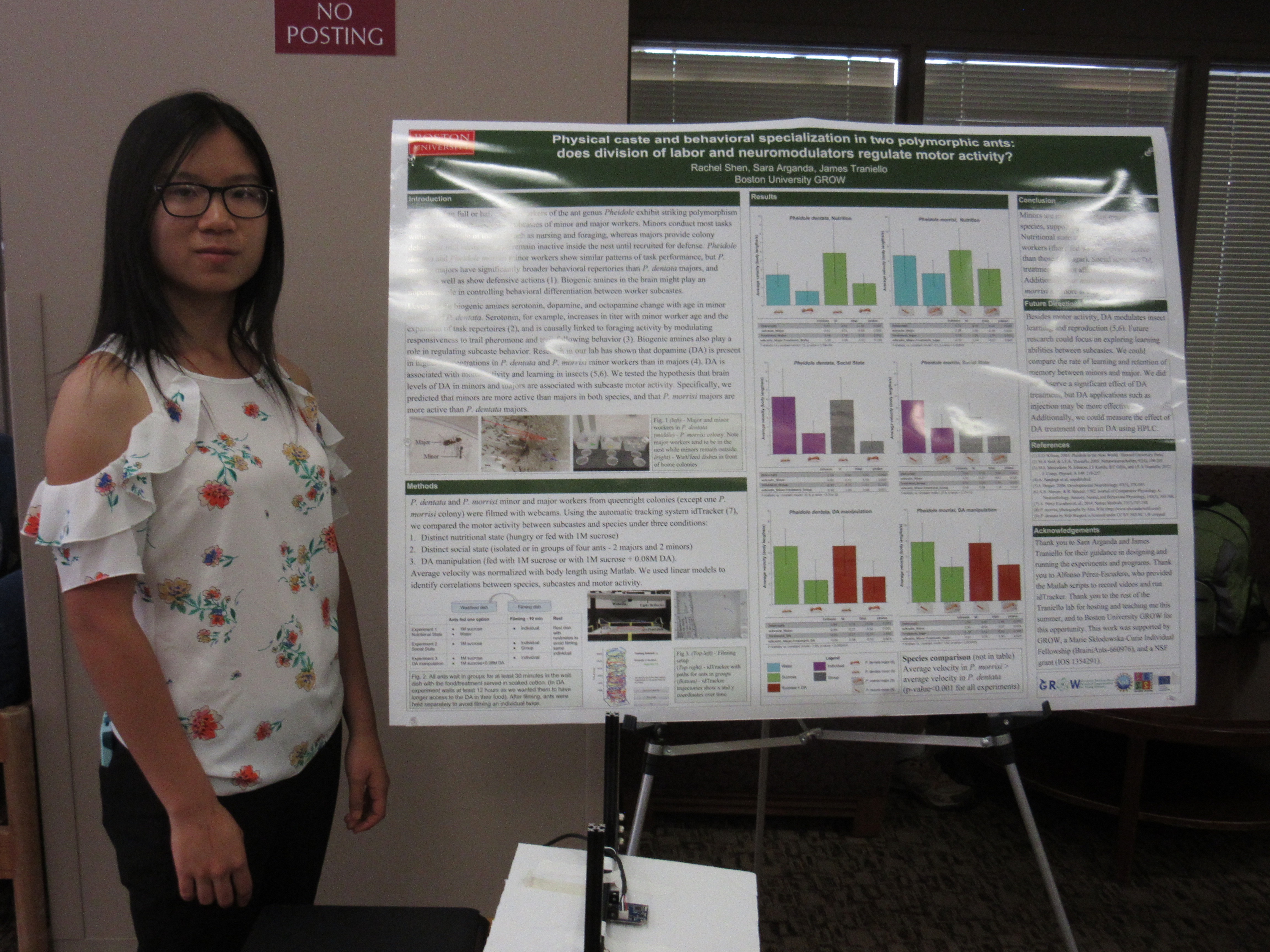
Workers in the polymorphic ant genus Pheidole typically have two behaviorally distinct worker subcastes, minors (which specialize in nursing and foraging) and majors (which specialize in defense). P. dentata and P. morrisi minors show similar patterns of task performance, but P. morrisi majors have a significantly broader task repertoire than P. dentata majors. Motor activity variation may underscore these subcaste task repertoire differences, and biogenic amines may modulate subcaste-related motor activity. Dopamine (DA), a biogenic amine neuromodulator associated with motor activity in insects, is present in higher concentrations in the brains of P. dentata and P. morrisi minors than in those of majors. We predicted that minors are more active than majors in both species, and tested the hypothesis that brain levels of DA in minors and majors control subcaste differences in motor activity. Using idTracker, an automatic animal tracking program, we compared the average velocities of P. dentata and P. morrisi minor and major workers in different nutritional states, social states, and experimentally manipulated DA levels. Statistical analyses revealed that minors of both species are more active than majors, supporting our hypothesis. Nutritional state affected only P. dentata: workers fed only water were less active than those fed sugar. Social state and DA treatment did not affect motor activity in either species. Additionally, our analyses revealed that P. morrisi are more active than P. dentata. Though higher DA brain concentrations correlate with greater motor activity, further studies are needed to establish a causal relationship between DA brain concentration and motor activity.
Sea urchin is an organism that can be used to study the development of the skeleton, highly because they are simple to work with and the signal they create is similar to the signal involved in human development. PMC is a type of cells that create the skeleton. PMC shows the patterning of skeleton expressed by the ectoderm. During the formation of embryo’s skeleton, there is different patterns and signal such as 5-S-HETE that work together to develop sea urchin Embryos. MK 886 is FLAP( five lipoxygenase activation enzyme) inhibitor. BW- B70C, Bay X-1005, and Stearda are drugs used to inhibit 5 LOX which is the enzyme that catalyzes the formation of leukotrienes from arachidonic acid. The connection between ???the role of 5 Lox and skeleton patterning is still unclear. No one has looked into this topic deeply until 5 LOX was identified as a candidate that played a role for skeleton patterning defects by previous Bradham researcher. ???Using a higher amount of concentration would cause embryos to have a different phenotype. We used Primary Mesenchyme Cells (PMC) to determine what role have these drugs played with 5 LOX enzyme to form a skeleton. We treated 14-hour old embryos with different drugs then waited to see different phenotype and compared the treated embryos with control. Different type of techniques that were used during the experiment was imaging for tissue and skeleton. We immunostain the embryos to see how PMC are working together to form the skeleton and see if there is any patterning during the formation of the skeleton.

Within the cardiovascular system, there is a subset of cells called vascular smooth muscle cells (VSMCs) that serve to contract or relax as a response to blood flow. The contraction of VSMCs is completed with the assistance of focal adhesions (FAs), sites that connect the extracellular matrix (ECM) to neighboring cells. This study focuses on broadening the understanding of the mechanisms of arterial stiffness by mechanically quantifying the contraction of viable VSMCs by using potassium chloride (KCl). Such research has never been conducted because of failure to integrate the biological and mechanical fields in studying arterial stiffness. As KCl was flushed through the arteries, the vessels were put through a series of pressure inflation-deflation tests on a pressure myograph that represented in vivo conditions. The changes in pressure, diameter, and axial force were continuously recorded and graphs of hysteresis were created based on those results. The data collected from the study showed that KCl influences arterial contraction in viable VSMCs. There is still more research to be done in regards to fully understanding the processes of arterial stiffness. Therefore, the next step is to study the mechanics of contraction at the macro level, specifically, the role that the enzyme Src Kinase plays in contraction and relaxation. Overall, this study was conducted to provide researchers with insight into the properties of arterial stiffness, a precursor for cardiovascular disease, thus allowing for the development of potential therapeutic interventions to combat it.
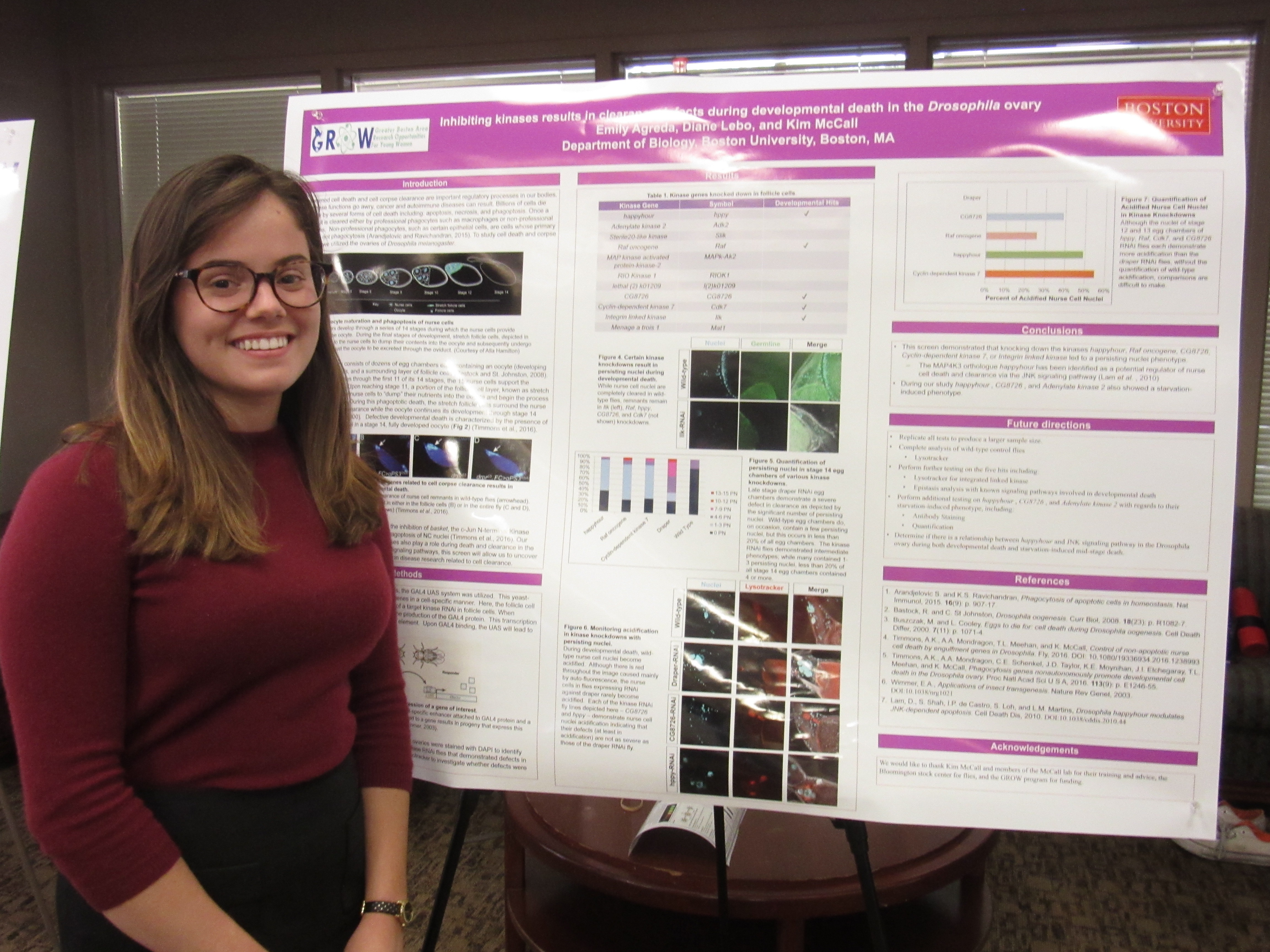
Programmed cell death and cell corpse clearance are important regulatory processes that, when tempered, can lead to various autoimmune diseases and cancer. To identify the proteins that regulate cell death and corpse clearance, the McCall lab utilizes the ovaries of Drosophila melanogaster where several death modalities have been observed. For instance, in well-fed Drosophila, normal development of an oocyte requires the phagoptosis, non-autonomous death, of the supportive nurse cells by stretch follicle cells. Defects in the developmental death and clearance of nurse cells result in persisting nuclei in the developed oocyte. An RNAi screen was performed for 11 kinases to investigate their role in nurse cell clearance in developmental death. As kinases are key signaling proteins, they may play a role in the signaling between nurse cells and the follicle cells during phagoptotic death. From this screen, the Raf oncogene, Cyclin-dependent kinase 7, integrin linked kinase, an uncharacterized gene CG8726, and the MAP4K3 orthologue happyhour were identified as potential regulators of nurse cell death and clearance.